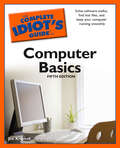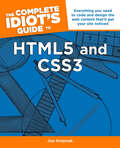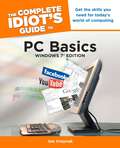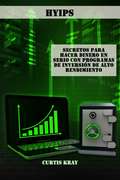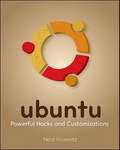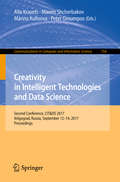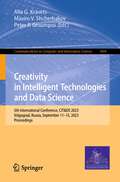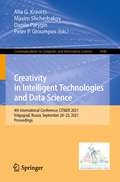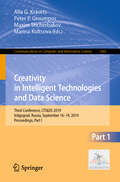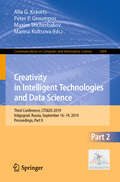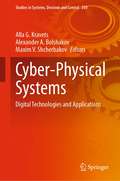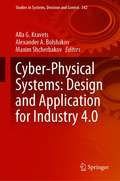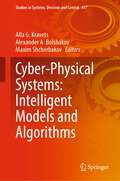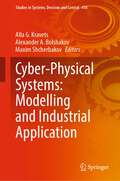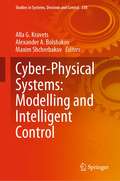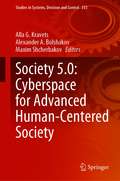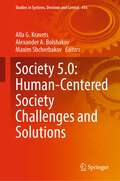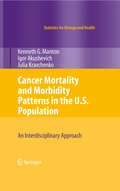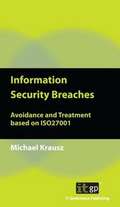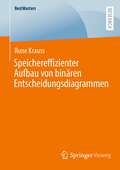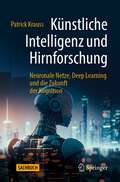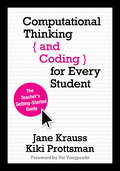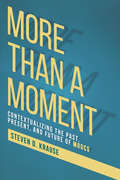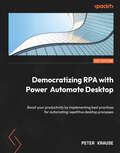- Table View
- List View
The Complete Idiot's Guide to Computer Basics, 5th Edition
by Joe KraynakTime for an upgrade! The fifth edition of The Complete Idiot's Guide® to Computer Basics places the reader in charge of the computer, rather than the other way around, and places the focus on software troubleshooting rather than hardware techno-babble. The reader wants to do something practical with his or her computer—this book shows them how.• Covers basic office programs and how to manage photo, video, and music files• Advice on safe web-surfing, including coverage of newsgroups, message boards, and mailing lists• New green computing initiatives that help protect the environment• Maintenance and upgrading information
The Complete Idiot's Guide to HTML5 and CSS3: Everything You Need to Code and Design the Web Content and That’ll Get Your Site
by Joe KraynakCreate dynamic, interactive websites with HTML5 and CSS3. HTML5 and CSS3 are the newest revisions of the primary standards for structuring and styling web content—major updates that enable designers and developers to streamline source code and publish more dynamic, interactive content without having to learn complex scripting languages. The Complete Idiot's Guide® to HTML5 and CSS3 provides both new and existing web developers the tools they need to code and design the web content that people increasingly expect to experience when they surf the web. Even better, you learn HTML5 and CSS3 in the context of building a website with a content management system (CMS), such as WordPress. You can then apply your knowledge of HTML5 and CSS3 to customize your site, instead of starting from scratch. You discover how to: • Design and maintain a website using web-based tools instead of a complicated HTML editor. • Code pages properly using the new HTML5 structure tags. • Embed audio and video using the new HTML5 tags. • Apply a CSS theme to format pages, and customize the theme using CSS3 styles. • Use CSS3 to round box corners and make images and backgrounds more or less transparent. • Take full advantage of new CSS3 transformation and animation features to animate objects on a page, create image rollovers, and build your own drop-down menus. • Test and fine-tune your site to make it load faster and look just right. • Perform an SEO audit of your site and keyword-optimize your site's content. The Complete Idiot's Guide® to HTML5 and CSS3 features: • 16-page color insert • HTML5 Quick Reference • CSS3 Properties and Values Quick Reference • HTML Special Characters and Symbols Quick Reference • Speak Like a Geek Glossary From the Author Although this book focuses primarily on HTML5 & CSS3, it presents these topics in the context of building a web site. When you're first getting started, building a site from scratch using only HTML and CSS can be overwhelming. You're usually better off starting with a content management system (CMS), such as WordPress, and a pre-designed theme. You can then use your knowledge of HTML5 and CSS3 to customize your site, instead of starting from scratch. This approach gets your site up and running as quickly as possible and allows you to learn more at a more comfortable pace.
The Complete Idiot's Guide to PC Basics, Windows 7 Edition
by Joe KraynakDiscover how to do just about anything with your Windows 7 PC The Complete Idiot's Guide® to PC Basics, Windows 7 Edition shows you how to do practical and fun stuff with your PC, including . . . Basics • Navigate and personalize Windows 7 • Manage disks, files, and folders • Install and uninstall programs • Use office applications, including a word processor and spreadsheet • Manage your personal finances • Get up and running with email Fun Stuff • Manage your digital photos and share them online • Transform a collection of photos into a movie and burn it to a DVD • Download music and transfer it to your MP3 player or CDs • Get connected with friends, family, and old school chums on Facebook • Tweet on Twitter • Discover cool features on Google you never knew existed • Watch and share video on YouTube • Find deals on eBay and other shopping sites • Create your own website or blog for free • Make free or really cheap phone calls all over the world with Skype For power users • Set up a home or small-business network • Protect your computer from viruses and other online threats • Upgrade and troubleshoot your PC From the Author You don't need to be a mechanic to drive a car, and you don't need to be a technician to use a computer. This book puts you in the driver's seat and shows you how to get where you're going with your computer, its software, and the Internet. Whether you want to manage your finances or your photos, connect with family and friends on Facebook, or buy and sell stuff on eBay, this book provides the step-by-step guidance that shows you how to do it.
Secretos para Hacer Dinero en Serio con Programas de Inversión de Alto Rendimiento (HYIPS)
by Curtis KrayDecidí escribir este libro para poder ayudar a todas esas decenas de miles de pequeños inversionistas que se han integrado a Programas de Inversión de Alto Rendimiento (HYIPs) cada año con la esperanza de hacer dinero suficiente para vivir y que, invariablemente han terminado seriamente devastados. Estoy convencido de que la mayoría de la gente que pierde dinero al invertir en HYIPs, carece de la información fundamental sobre su funcionamiento, sobre quienes integran éste juego, y sobre cuál es su verdadera motivación. Para que todos los procesos intelectuales, actitudes y trampas que se tienen que enfrentar puedan entenderse fácilmente es que he escrito este libro. Con la información que se incluye en él, se podrán aprovechar desde distintos ángulos, ingeniosas oportunidades que pondrán en ventaja al inversionista para generar grandes cantidades de dinero.
Ubuntu
by Neal KrawetzTune, tweak, and change the popular Ubuntu Linux operating system!Ubuntu is a community developed, Linux-based operating system that is perfect for laptops, desktops, and servers, and is used by millions of people around the world. This book provides you with practical hacks and tips that are not readily available online, in FAQ files, or any other Ubuntu book on the market so that you can customize your Ubuntu system for your specific needs.Bridging the gap between introductory information and overly technical coverage, this unique resource presents complex hacks and ways to extend them. You'll feast on numerous tips, hints, and little-known secrets for getting the most out of your Ubuntu system.Coverage includes:Hacking the InstallationSelecting a DistributionSelecting the Ubuntu VersionThe 10-Step Boot ConfigurationBooting Variations and TroubleshootingTweaking the BusyBoxUpgrading Issues with UbuntuConfiguring GRUBCustomizing the User EnvironmentConfiguring DevicesAdapting Input DevicesManaging SoftwareCommunicating OnlineCollaboratingTuning ProcessesMultitasking ApplicationsLocking Down UbuntuAdvanced NetworkingEnabling ServicesIf you're a power user hungry for cutting-edge hacks to intensify your Ubuntu system, then this is the book for you!Note: CD-ROM/DVD and other supplementary materials are not included as part of eBook file.
Creativity in Intelligent Technologies and Data Science: Second Conference, CIT&DS 2017, Volgograd, Russia, September 12-14, 2017, Proceedings (Communications in Computer and Information Science #754)
by Alla Kravets Maxim Shcherbakov Marina Kultsova Peter GroumposThis book constitutes the refereed proceedings of the First Conference on Creativity in Intelligent Technologies and Data Science, CIT&DS 2015, held in Volgograd, Russia, in September 2015. The 66 revised full papers and two short papers presented were carefully reviewed and selected from 208 submissions. The papers are organized in topical sections on computational creativity for science and design; knowledge discovery in patent and open sources for creative tasks; software computer-aided design and agent-based systems; conceptual, cognitive and qualitative modeling with application in intelligent decision making; design creativity in CAD/CAM/CAE/PDM; intelligent decision support for continual improvement process; data science in energy management, transportation and urban development; data science in social networks analysis; natural language and image processing and analysis; game-based learning technologies in engineering education and educational games design; personalized learning in Web-based intelligent educational systems; e-inclusion: development of smart mobile applications for people with disabilities.
Creativity in Intelligent Technologies and Data Science: 5th International Conference, CIT&DS 2023, Volgograd, Russia, September 11–15, 2023, Proceedings (Communications in Computer and Information Science #1909)
by Alla G. Kravets Maxim V. Shcherbakov Peter P. GroumposThis book constitutes the proceedings of the 5th Conference on Creativity in Intellectual Technologies and Data Science, CIT&DS 2023, held in Volgograd, Russia, in September 2023.The 40 regular papers and 2 keynote papers presented were carefully reviewed and selected from 148 submissions. The papers are organized in the following topical sections: Artificial intelligence and deep learning technologies for creative tasks. Knowledge discovery in patent and open sources; Artificial intelligence & Deep Learning Technologies for Creative tasks. Open science semantic technologies; Artificial intelligence and deep learning technologies for creative tasks. Computer vision and knowledge-based control; Cyber-physical systems and big data-driven control: pro-active modeling in intelligent decision making support; Cyber-Physical Systems & Big Data-driven world. Industrial creativity in CASE/CAI/CAD/PDM; Cyber-Physical Systems & Big Data-driven world. Intelligent Internet of Services and Internet of Things; Intelligent Technologies in Social Engineering. Data Science in Social Networks Analysis and Cyber Security; Intelligent Technologies in Social Engineering. Creativity & Game-Based Learning; Intelligent Technologies in Social Engineering. Intelligent Technologies in Medicine& Healthcare; Intelligent Technologies in Social Engineering. Intelligent technologies in Urban Design&Computing.
Creativity in Intelligent Technologies and Data Science: 4th International Conference, CIT&DS 2021, Volgograd, Russia, September 20–23, 2021, Proceedings (Communications in Computer and Information Science #1448)
by Alla G. Kravets Maxim Shcherbakov Danila Parygin Peter P. GroumposThis book constitutes the proceedings of the 4th Conference on Creativity in Intellectual Technologies and Data Science, CIT&DS 2021, held in Volgograd, Russia, in September 2021.The 39 full papers, 7 short papers, and 2 keynote papers presented were carefully reviewed and selected from 182 submissions. The papers are organized in the following topical sections: Artificial intelligence and deep learning technologies: knowledge discovery in patent and open sources; open science semantic technologies; IoT and computer vision in knowledge-based control; Cyber-physical systems and big data-driven control: pro-active modeling in intelligent decision making support; design creativity in CASE/CAI/CAD/PDM; intelligent technologies in urban design and computing; Intelligent technologies in social engineering: data science in social networks analysis and cyber security; educational creativity and game-based learning; intelligent assistive technologies: software design and application.
Creativity in Intelligent Technologies and Data Science: Third Conference, CIT&DS 2019, Volgograd, Russia, September 16–19, 2019, Proceedings, Part I (Communications in Computer and Information Science #1083)
by Alla G. Kravets Peter P. Groumpos Maxim Shcherbakov Marina KultsovaThis two-volume set constitutes the proceedings of the Third Conference on Creativity in Intellectual Technologies and Data Science, CIT&DS 2019, held in Volgograd, Russia, in September 2019.The 67 full papers, 1 short paper and 3 keynote papers presented were carefully reviewed and selected from 231 submissions. The papers are organized in topical sections in the two volumes. Part I: cyber-physical systems and Big Data-driven world. Part II: artificial intelligence and deep learning technologies for creative tasks; intelligent technologies in social engineering.
Creativity in Intelligent Technologies and Data Science: Third Conference, CIT&DS 2019, Volgograd, Russia, September 16–19, 2019, Proceedings, Part II (Communications in Computer and Information Science #1084)
by Alla G. Kravets Peter P. Groumpos Maxim Shcherbakov Marina KultsovaThis two-volume set constitutes the proceedings of the Third Conference on Creativity in Intellectual Technologies and Data Science, CIT&DS 2019, held in Volgograd, Russia, in September 2019.The 67 full papers, 1 short paper and 3 keynote papers presented were carefully reviewed and selected from 231 submissions. The papers are organized in topical sections in the two volumes. Part I: cyber-physical systems and Big Data-driven world. Part II: artificial intelligence and deep learning technologies for creative tasks; intelligent technologies in social engineering.
Cyber-Physical Systems: Digital Technologies and Applications (Studies in Systems, Decision and Control #350)
by Alla G. Kravets Alexander A. Bolshakov Maxim V. ShcherbakovThis book offers ideas to help improve digital technologies and increase their efficiency during implementation and application for researchers and practitioners. The outstanding position of the book among others is that it dwells with cyber-physical systems’ progress and proposes ideas and finding around digital tools and technologies and their application. A distinguished contribution is in presenting results on Digital Twins development and application, enhancing approaches of communication and information transferring between cyber-physical systems connected within the Internet of things platforms, computer linguistic as a part of cyber-physical systems, intelligent cybersecurity and computer vision systems. The target audience of this book also includes practitioners and experts, as well as state authorities and representatives of manufacturing and industry who are interested in creating and implementing of cyber-physical systems in framework of digitalization projects.
Cyber-Physical Systems: Design and Application for Industry 4.0 (Studies in Systems, Decision and Control #342)
by Alla G. Kravets Alexander A. Bolshakov Maxim ShcherbakovThis book consists of chapters dedicated to the questions of cyber-physical system design and its usage for the chemical industry and new material design. Also, the contribution of the book covers scientific research and their results for cyber-physical systems design and application in the energy domain and solutions regarding engineering education for cyber-physical systems design. The book offers unique content for researchers and practitioners who are looking for new knowledge and skills in the framework of Industry 4.0 solutions. The book also benefits researchers and practitioners in chemistry and new material design and manufacturing to understand how cyber-physical systems can be applied to increase efficiency and performance. The target audience of the book are practitioners, enterprises representatives, scientists, Ph.D. and master students who perform scientific research or applications of cyber-physical systems in the concept of Industry 4.0.
Cyber-Physical Systems: Intelligent Models and Algorithms (Studies in Systems, Decision and Control #417)
by Alla G. Kravets Alexander A. Bolshakov Maxim ShcherbakovThis book is devoted to intelligent models and algorithms as the core components of cyber-physical systems. The complexity of cyber-physical systems developing and deploying requires new approaches to its modelling and design. Presents results in the field of modelling technologies that leverage the exploitation of artificial intelligence, including artificial general intelligence (AGI) and weak artificial intelligence. Provides scientific, practical, and methodological approaches based on bio-inspired methods, fuzzy models and algorithms, predictive modelling, computer vision and image processing. The target audience of the book are practitioners, enterprises representatives, scientists, PhD and Master students who perform scientific research or applications of intelligent models and algorithms in cyber-physical systems for various domains.
Cyber-Physical Systems: Modelling and Industrial Application (Studies in Systems, Decision and Control #418)
by Alla G. Kravets Alexander A. Bolshakov Maxim ShcherbakovThis book discusses the open questions regarding the modelling of cyber-physical systems and their application in different industries. The industry needs new approaches to improve its competitiveness. The concept of cyber-physical systems supports such changes, with the need to find new modelling tools becoming a key challenge. The book contains five-section covering the following topics: cyber-physical systems modelling, IoT and signal processing, cyber-physical systems intelligent control, cyber-physical systems industrial implementation and the production of the new material for cyber-physical systems. These approaches, on the one hand, should ensure the execution of current business processes, and on the other hand, ensure a quick speed of reactions to changes. The target audience of the book are practitioners, enterprises representatives, scientists, PhD and Master students who perform scientific research on modelling and industrial application of cyber-physical systems.
Cyber-Physical Systems: Modelling and Intelligent Control (Studies in Systems, Decision and Control #338)
by Alla G. Kravets Alexander A. Bolshakov Maxim ShcherbakovThis book highlights original approaches of modelling and intelligent control of cyber-physical systems covering both theoretical and practical aspects. The novel contribution of the book covers the transformation of scientific research and their results into applications for cyber-physical systems design and operation during the whole life cycle in different domains. Given its scope, the book offers an excellent reference book for researchers and other readers in the fields of cyber-physical systems modelling and intelligent control, space exploration and practical implementation of cyber-physical systems. The book also benefits researchers and practitioners in artificial intelligence and machine learning, as described results can be applied in cyber-physical systems design and cost-effectively maintenance. The target audience of this book also includes practitioners and experts, as well as state authorities and representatives of international organizations interested in creating mechanisms for implementing Cyber-Physical Systems projects.
Society 5.0: Cyberspace for Advanced Human-Centered Society (Studies in Systems, Decision and Control #333)
by Alla G. Kravets Alexander A. Bolshakov Maxim ShcherbakovThis book includes new findings on socio-economic cyber systems control and development approaches based on AI and data-driven techniques. The authors determine key social challenges and the main features of management and modeling processes. To enhance the efficiency of the socio-economic process, new approaches were suggested as well as its components based on the concept of Society 5.0. In this book, the authors substantiate the scientific, practical, and methodological approaches to the smart technologies’ development. The core is a human-centered concept of cyber systems as well as the intelligent paradigm. Approaches combined both mathematical models and data processing techniques are also proposed as advanced methods for smart system design for ecology and health care. The implementations of the developed prototypes, including testing in real domains, which have collected and analyzed big data and proved their effectiveness, are presented. The target audience of the book are practitioners, enterprise representatives, scientists, and Ph.D. and Master students who perform scientific research or applications of socio-economic cyber systems in different domains.
Society 5.0: Human-Centered Society Challenges and Solutions (Studies in Systems, Decision and Control #416)
by Alla G. Kravets Alexander A. Bolshakov Maxim ShcherbakovThis book focuses on open issues of Society 5.0, a new paradigm of a society that balances a human-centred approach and technologies based on cyber-physical systems and artificial intelligence. The book contains results of how intelligent or cyber-physical systems help to improve the quality of life in society despite new challenges. Discusses implemented breakthrough systems, models, programs, and methods that cover the following topics: biomedicine and healthcare, innovations in socio-economic systems, intelligent energetics, advances in transport systems, human-centric technologies. These approaches help to improve human society using cyber-physical systems in a dramatically changing environment. The target audience of the book are practitioners, enterprises representatives, scientists, PhD and Master students who perform scientific research on the application of cyber-physical systems towards Society 5.0.
Cancer Mortality and Morbidity Patterns in the U.S. Population: An Interdisciplinary Approach (Statistics for Biology and Health)
by Julia Kravchenko Igor Akushevich K. G. MantonThe purpose of this book is to examine the etiology of cancer in large human populations using mathematical models developed from an inter-disciplinary perspective of the population epidemiological, biodemographic, genetic and physiological basis of the mechanisms of cancer initiation and progression. In addition an investigation of how the basic mechanism of tumor initiation relates to general processes of senescence and to other major chronic diseases (e.g., heart disease and stroke) will be conducted.
Information Security Breaches: Avoidance and Treatment Based on ISO27001
by Michael KrauszWiden the horizon of your Information Security Knowledge!Although breaches of information security are not a new phenomenon, the methods used to perpetrate such breaches have changed considerably over the years. Leaking information to non-authorised people has always been an issue but, in the computer age, the speed and effectiveness with which breaches of information security can occur, and the amount of harm potentially caused are disturbing. Typically, also, they favour the perpetrator, not the victim. The process outlinedThis pocket guide outlines a process and its elements for the treatment of severe breaches, and places them in the context of the associated ISO27001 controls. It provides input for decision making and breach classification, and case studies where the reader can check out how other companies were affected and what they did, or did not do, upon becoming the victim of a breach. Intended to serve two purposes. . . Firstly, this title provides a general discussion of what information security breaches are, how they can be treated, and what ISO27001 offers in that respect, illustrated with details of real-life information security incidents. It aims to serve as a facilitator to widen the horizon of the reader seeking knowledge, or as an introduction for those who arejust starting to think about information security. Secondly, it will form a first line of defence for the reader who is the victim of an incident and is looking for guidance and direction. Here, it will help the reader by identifying, discussing and evaluating treatment options and, through the case studies, it will reduce the tension of the situation readers may find themselves in once abreach occurs. The audienceThis guide is aimed at CSOs, CISOs, IT Security Managers, CIOs and, last but not least, CEOs. It particularly addresses personnel in non-IT roles, in an effort to make this unwieldy subject more comprehensible to those who, in a worst-case scenario, will be on the receiving end of requests for six- or seven-figure excess budgets to copewith severe incidents.
Speichereffizienter Aufbau von binären Entscheidungsdiagrammen (BestMasters)
by Rune KraussAufgrund der steigenden Komplexität von Hardwaresystemen besteht die Notwendigkeit, effizientere Datenstrukturen und darauf operierende Algorithmen zu entwickeln, um weiterhin das korrekte Verhalten solcher Systeme zu garantieren. Ein binäres Entscheidungsdiagramm ist eine geeignete Datenstruktur, da sie eine kompakte Repräsentation boolescher Funktionen und effiziente Algorithmen zur Manipulation dieser bietet. Allerdings haben Entscheidungsdiagramme auch Herausforderungen zu bewältigen: Die Praktikabilität hängt von deren Minimierung ab und es besteht ein großer Speicherbedarf für einige komplexe Funktionen. Dieses Buch präsentiert Ansätze, in denen boolesche Normalformen unter Ordnungsdefinitionen und Gesetzen der booleschen Algebra mit dem Ziel angeordnet werden, die Anzahl an Zwischenberechnungen zum Aufbau binärer Entscheidungsdiagramme zu verringern und den Speicher- sowie Zeitbedarf zu reduzieren. Die Methoden werden in ein Softwarepaket integriert, um die Performanz anhand von Benchmark-Instanzen zu untersuchen und mit dem Stand der Forschung zu vergleichen.
Künstliche Intelligenz und Hirnforschung: Neuronale Netze, Deep Learning und die Zukunft der Kognition
by Patrick KraussWie funktioniert Künstliche Intelligenz (KI) und gibt es Parallelen zum menschlichen Gehirn? Was sind die Gemeinsamkeiten von natürlicher und künstlicher Intelligenz, und was die Unterschiede? Ist das Gehirn nichts anderes als ein biologischer Computer? Was sind Neuronale Netze und wie kann der Begriff Deep Learning einfach erklärt werden?Seit der kognitiven Revolution Mitte des letzten Jahrhunderts sind KI und Hirnforschung eng miteinander verflochten. Im Bereich der KI gab es in den letzten Jahren mehrere spektakuläre Durchbrüche, von alphaGo über DALL-E 2 bis ChatGPT, die so bis vor kurzem noch völlig undenkbar waren. Doch schon heute arbeiten Forscher an den Innovationen von morgen, wie hybrides maschinelles Lernen oder neuro-symbolische KI. Aber was verbirgt sich dahinter überhaupt?Anhand aktueller Forschungsergebnisse und spannender Beispiele aus der Praxis bietet dieses Sachbuch einen verständlichen Einstieg in die Grundlagen und Herausforderungen dieser faszinierenden Disziplinen. Sie erfahren, was Neurowissenschaft und Psychologie über die Funktionsweise des Gehirns wissen und wie Künstliche Intelligenz arbeitet. Lernen Sie zudem, wie KI unser Verständnis des Gehirns revolutioniert hat und wie Erkenntnisse aus der Hirnforschung umgekehrt in der Informatik eingesetzt werden, um KI-Algorithmen weiterzuentwickeln. Entdecken Sie die faszinierende Welt dieser beiden Disziplinen. Erfahren Sie, warum Künstliche Intelligenz und Hirnforschung zwei Seiten einer Medaille sind und wie sie unsere Zukunft prägen werden.
Computational Thinking and Coding for Every Student: The Teacher’s Getting-Started Guide
by Jane Krauss Kiki ProttsmanEmpower tomorrow’s tech innovators Our students are avid users and consumers of technology. Isn’t it time that they see themselves as the next technological innovators, too? Computational Thinking and Coding for Every Student is the beginner’s guide for K-12 educators who want to learn to integrate the basics of computer science into their curriculum. Readers will find Practical strategies for teaching computational thinking and the beginning steps to introduce coding at any grade level, across disciplines, and during out-of-school time Instruction-ready lessons and activities for every grade Specific guidance for designing a learning pathway for elementary, middle, or high school students Justification for making coding and computer science accessible to all A glossary with definitions of key computer science terms, a discussion guide with tips for making the most of the book, and companion website with videos, activities, and other resources Momentum for computer science education is growing as educators and parents realize how fundamental computing has become for the jobs of the future. This book is for educators who see all of their students as creative thinkers and active contributors to tomorrow’s innovations. "Kiki Prottsman and Jane Krauss have been at the forefront of the rising popularity of computer science and are experts in the issues that the field faces, such as equity and diversity. In this book, they’ve condensed years of research and practitioner experience into an easy to read narrative about what computer science is, why it is important, and how to teach it to a variety of audiences. Their ideas aren’t just good, they are research-based and have been in practice in thousands of classrooms…So to the hundreds and thousands of teachers who are considering, learning, or actively teaching computer science—this book is well worth your time." Pat Yongpradit Chief Academic Officer, Code.org
Computational Thinking and Coding for Every Student: The Teacher’s Getting-Started Guide
by Jane Krauss Kiki ProttsmanEmpower tomorrow’s tech innovators Our students are avid users and consumers of technology. Isn’t it time that they see themselves as the next technological innovators, too? Computational Thinking and Coding for Every Student is the beginner’s guide for K-12 educators who want to learn to integrate the basics of computer science into their curriculum. Readers will find Practical strategies for teaching computational thinking and the beginning steps to introduce coding at any grade level, across disciplines, and during out-of-school time Instruction-ready lessons and activities for every grade Specific guidance for designing a learning pathway for elementary, middle, or high school students Justification for making coding and computer science accessible to all A glossary with definitions of key computer science terms, a discussion guide with tips for making the most of the book, and companion website with videos, activities, and other resources Momentum for computer science education is growing as educators and parents realize how fundamental computing has become for the jobs of the future. This book is for educators who see all of their students as creative thinkers and active contributors to tomorrow’s innovations. "Kiki Prottsman and Jane Krauss have been at the forefront of the rising popularity of computer science and are experts in the issues that the field faces, such as equity and diversity. In this book, they’ve condensed years of research and practitioner experience into an easy to read narrative about what computer science is, why it is important, and how to teach it to a variety of audiences. Their ideas aren’t just good, they are research-based and have been in practice in thousands of classrooms…So to the hundreds and thousands of teachers who are considering, learning, or actively teaching computer science—this book is well worth your time." Pat Yongpradit Chief Academic Officer, Code.org
More than a Moment: Contextualizing the Past, Present, and Future
by Steven D. KrauseAs recently as 2012, massive open online courses (MOOCs) looked poised to revolutionize higher education, but in just a few years their flaws and problems have made them into a less relevant model. In More than a Moment, Steven D. Krause explores MOOCs and their continuing impact on distance learning in higher education, putting them in the context of technical innovations that have come before and those that will be part of the educational future. Krause writes about his own experiences as a participant in several MOOCs and the experiences of faculty who developed and taught MOOCs. Contrary to many early claims from educational entrepreneurs, they were never entirely “new,” and MOOCs and their aftermath are still at the heart of the tensions between nonprofit universities and for-profit entities, particularly online program management firms, in delivering distance education. While MOOCs are no longer a threat to education in the United States, they are part of the ongoing corporatization of education and remain part of conversations about experienced-based credit, corporate training, and open education. Presenting historical, student, teacher, and administrative perspectives, More than a Moment is a well-rounded treatment that will be of interest to academics and entrepreneurs interested in distance education, online pedagogy, online program management, and public-private partnerships in higher education.
Democratizing RPA with Power Automate Desktop: Boost your productivity by implementing best practices for automating repetitive desktop processes
by Peter KrauseDiscover how desktop flows can interact with your everyday tools and automate tasks, freeing up time to do more important thingsPurchase of the print or Kindle book includes a free PDF eBookKey FeaturesLearn how Office programs can assist with automating recurring tasksMaintain superior work quality by including daily desktop and web applications in your flowsEnrich your flows with additional AI-based information and integrate them with cloud systemsBook DescriptionWhether you want to organize simple files or perform more complex consolidations between different Office programs and remote-control applications that don't allow outside access, Power Automate Desktop helps meet these challenges. This book shows you how to leverage this workflow automation platform by explaining the underlying RPA concepts in a step-by-step way. You'll start with simple flows that can be easily recorded and further processed using the built-in recorder. Later, you'll learn how to use the more advanced actions to automate folder and file management and enable Office programs to interact with each other. You'll also get to grips with integrating desktop flows into other cloud environments and further enhance their value using AI. As you progress, you'll understand how flows can run unattended and how they are managed in the Power Platform, as well as key concepts such as creating, modifying, debugging, and error-handling UI flows. Finally, the book will guide you to use Process Automation Designer (PAD) in conjunction with your frequently used desktop systems to automate routine tasks. By the end of this book, you'll have become a Power Automate Desktop expert, automating both professional and personal tasks.What you will learnMaster RPA with Power Automate Desktop to commence your debut flowGrasp all essential product concepts such as UI flow creation and modification, debugging, and error handlingUse PAD to automate tasks in conjunction with the frequently used systems on your desktopAttain proficiency in configuring flows that run unattended to achieve seamless automationDiscover how to use AI to enrich your flows with insights from different AI modelsExplore how to integrate a flow in a broader cloud contextWho this book is forWhether you're a home user looking to automate simple tasks on your workstation or a business user or citizen developer seeking to automate more complex rule-based processes, this book will help you overcome the challenge. No knowledge of a programming language is required, but in the more advanced chapters, a general understanding of information technology, including basic programming language structures, protocols, and cloud concepts, will be helpful.
